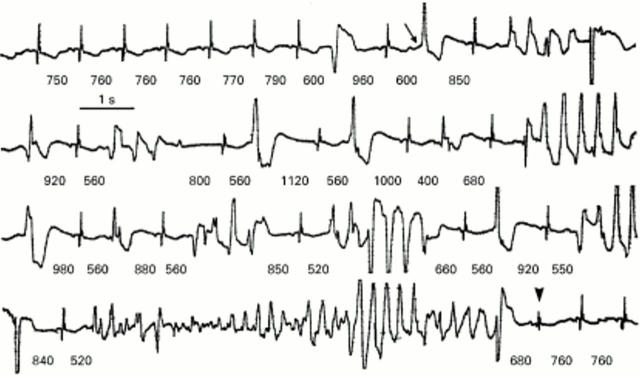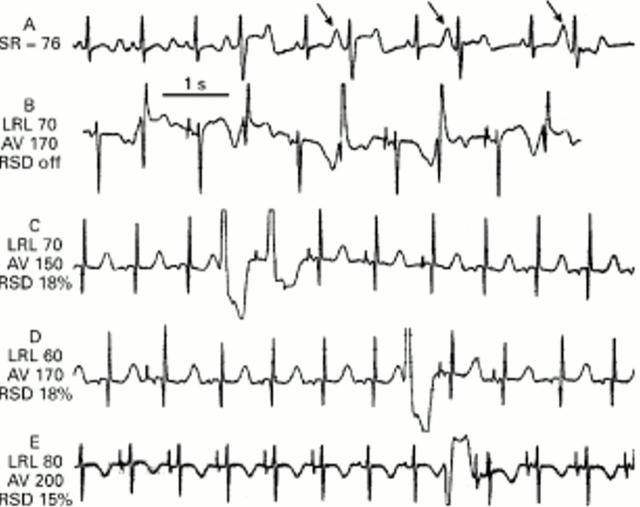Abstract
Torsade de pointes in the congenital long QT syndrome (LQTS) is often pause dependent. Thus, the main goal of pacemaker treatment in the LQTS may be the prevention of pauses that facilitate the onset of torsade de pointes. A pause prevention pacing algorithm (rate smoothing) was used for arrhythmia prevention in a 14 year old girl with congenital LQTS. By temporarily increasing the pacing rate after spontaneous premature beats, rate smoothing down of 18% prevented postextrasystolic pauses, pause related T-U changes, and recurrence of pause induced torsade de pointes. Rate smoothing is a potentially useful tool that ought to be evaluated for the prevention of torsade de pointes in the LQTS. Keywords: long QT syndrome; torsade de pointes; ventricular fibrillation; ventricular tachycardia; pacing
Full Text
The Full Text of this article is available as a PDF (100.3 KB).
Figure 1 .
Representative example of pause dependent torsade de pointes. The R-R intervals (shown in milliseconds) gradually increase due to sinus arrhythmia until a sinus cycle of 790 ms is followed by the first premature depolarisation. This extrasystole generates a longer pause (a postextrasystolic pause of 960 ms), which is followed by a sinus complex with postextrasystolic U wave augmentation (arrow) and a new premature depolarisation. The long-short sequence is perpetuated, leading to longer and faster runs of torsade de pointes. Fortuitously, the longest run is followed by a relatively short sinus cycle (arrowhead) and the vicious cycle (long-short sequence) terminates.
Figure 2 .
Electrocardiograms following implantation of a permanent DDDR pacemaker with rate smoothing algorithm. SR, sinus rate; LRL, AV, and RSD, programmed lower rate limit (beats/min), AV delay (in milliseconds), and rate smoothing down values (expressed as percentage of the previous R-R interval), respectively. (A) Sinus rate 76 beats/min; a premature complex is followed by a postextrasystolic pause. The ensuing sinus complex has marked post-pause U wave changes (arrow). Ventricular bigeminy (long-short sequence) supervenes. (B) DDD pacing (atrial capture with atrioventricular conduction). Rate smoothing is off. Spontaneous extrasystoles are sensed appropriately, resetting the pacemaker and causing short-long sequences that are perpetuated as ventricular bigeminy. Note the marked postextrasystolic T-U changes after each long interval. (C) Rate smoothing down of 18% during pacing with a relatively slow lower rate limit. After three sinus complexes there is a spontaneous extrasystole. Due to rate smoothing, DDD pacing occurs at a rate faster than the programmed lower rate limit: the first paced cycle is 18% longer than the coupling interval of the extrasystole. There is no atrial capture and there is retrograde conduction from the paced ventricular complex. The next three complexes show atrial pacing and capture with normal atrioventricular conduction. Each paced cycle is 18% longer than the previous one until sinus rhythm ensues. Note the absence of pauses and the absence of T-U changes. (D) Another example of rate smoothing down during DDD pacing with a slow lower rate limit (60 beats/min). An extrasystole triggers atrial pacing (with atrioventricular conduction) and the rate decreases by 18% each cycle. (E) Pacing at 80 beats/min and rate smoothing down of 15%. An extrasystole is followed by more rapid pacing. The first paced complex shows atrial capture and ventricular pseudofusion.




